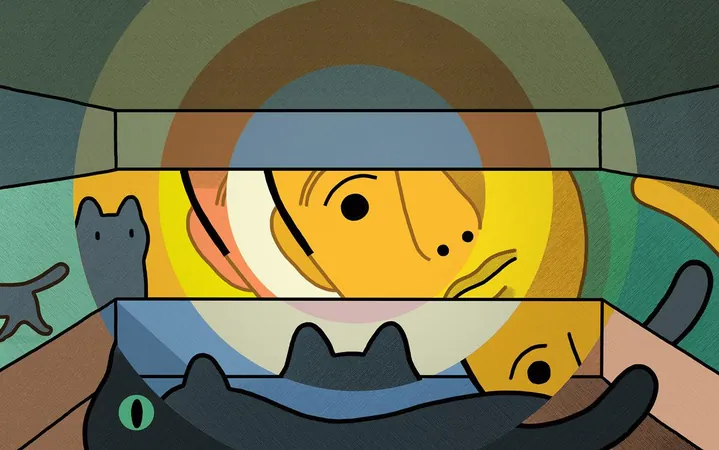
The Truth About Schrödinger’s Cat: Alive or Dead?
2025-04-28
Author: Ming
The Quantum Quandary of Schrödinger’s Cat
Back in 1935, Austrian physicist Erwin Schrödinger stirred the pot of quantum mechanics with a biting critique that would echo through the ages. While most of his lengthy review was a technical exploration far from public interest, one cheeky paragraph ignited a fascination that endures nearly 90 years later: the infamous Schrödinger’s cat.
What’s the Cat’s Dilemma?
Imagine this: a cat locked in a steel chamber along with a devious device. Inside, a Geiger counter awaits a tiny piece of radioactive material that may—or may not—decay. If it does decay, the device activates, releasing a lethal poison. If it doesn’t decay, the cat remains blissfully alive. Quantum mechanics suggests that until we peek inside that box, both the living and dead states of the cat exist simultaneously.
Why Does This Matter?
At its core, Schrödinger’s thought experiment illustrates quantum superposition. Unlike classical objects, particles can behave simultaneously as waves and particles, creating a reality where probabilities reign. Thus, our cat is neither simply alive nor dead, but a bizarre mixture of both until we choose to observe.
The Ripple Effect of Observation
According to quantum mechanics, until we lift the lid and check, we face a superposition of outcomes. This leads us to contemplate the consequences of our choices—what if we don’t look? As the narrative unfolds, one can’t help but feel an eerie camaraderie with the cat, caught in a paradox that reflects the unpredictability of life itself.
The Einstein Challenge
Not everyone was on board with Schrödinger's whimsical metaphor. Einstein found quantum mechanics' emphasis on probabilities unsettling, famously stating that 'God does not play dice.' The debates between Einstein and Schrödinger spurred deeper questions about the very nature of reality. Was Schrödinger’s cat merely a paradox, or did it highlight deeper flaws within quantum theory?
The Cultural Phenomenon
Fast forward to today, Schrödinger’s cat has clawed its way into mainstream culture, raising existential questions in a multitude of stories, films, and discussions. Its allure lies in the fundamental uncertainties of fate and the choices we make—akin to the concept of 'sliding doors' in life, where a single decision can lead us down vastly different paths.
Fiction Meets Science
Science fiction author Ursula Le Guin famously captured the essence of the paradox in her 1974 short story, using Schrödinger’s cat to illustrate the unpredictability of outcomes and our desire for certainty.
The Multiverse of Possibilities
This thought experiment opens doors to the 'Many Worlds' interpretation of quantum mechanics, where every choice creates parallel universes. Imagine a version of you experiencing every conceivable alternate reality—some kind, others harshly unyielding—simultaneously existing in a vast multiverse.
The Heart of Quantum Mechanics
Despite the whimsical nature of Schrödinger’s cat, many physicists contend that the paradox is a metaphorical representation, not a literal truth. Quantum theory, they argue, is less about the cat’s fate and more about understanding the unpredictable nature of reality.
Conclusion: The Fork in the Road
As we ponder the implications of Schrödinger’s cat, we're left at a crossroads between accepting quantum mechanics as a mathematical tool for predicting outcomes or seeking a more profound explanation for the universe’s weirdness. Which path will you choose?



 Brasil (PT)
Brasil (PT)
 Canada (EN)
Canada (EN)
 Chile (ES)
Chile (ES)
 Česko (CS)
Česko (CS)
 대한민국 (KO)
대한민국 (KO)
 España (ES)
España (ES)
 France (FR)
France (FR)
 Hong Kong (EN)
Hong Kong (EN)
 Italia (IT)
Italia (IT)
 日本 (JA)
日本 (JA)
 Magyarország (HU)
Magyarország (HU)
 Norge (NO)
Norge (NO)
 Polska (PL)
Polska (PL)
 Schweiz (DE)
Schweiz (DE)
 Singapore (EN)
Singapore (EN)
 Sverige (SV)
Sverige (SV)
 Suomi (FI)
Suomi (FI)
 Türkiye (TR)
Türkiye (TR)
 الإمارات العربية المتحدة (AR)
الإمارات العربية المتحدة (AR)